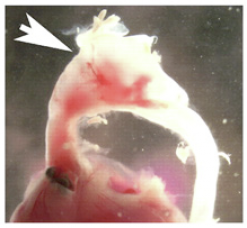This web page was produced as an assignment for Genetics 677, an Undergraduate course at UW-Madison
Discussion

Aorta dissection in a mutant fibrillin mouse (2)
Marfan syndrome patients can function in society as normal human beings with no intellectual disabilities. Often appearing as tall and agile, a good combination for athleticism, people do not realize the danger of death due heart failure. At the moment, the most immediate concern with Marfan syndrome is finding a method to improve diagnosis. Once a patient is diagnosed with Marfan, symptoms are monitored and treated as needed, such as the use of beta-blockers to treat aortic dilation. As this website has shown, the FBN1 gene is large with no common mutations that leads specifically to Marfan syndrome or other fibrillinopathies. Hence, no simple blood test exists to aid diagnosis. Doctors diagnose patients primarily by looking at family history and clinical evaluations and then refer to a list of major and minor criteria, known as Ghent Criteria.
Since the most detrimental aspect of the disease has to do with abnormal function in the heart, I focused my research on data found that related to heart function. When searching for DNA motifs found in the FBN1 gene, a tinman homolog was found (referred to as Nkx-2.5 in humans). In drosophila, it has been found that Tinman plays a significant role in heart development. Although no protein interactions were found through STRING and BioGRID between Fibrillin-1 and Nkx-2.5 in humans, a DNA motif on a gene suggests that Tinman would bind to the FBN1 gene. I am interested in understanding the role the Tinman motif plays in Fibrillin expression in the heart. I would like to create a mouse knock out of the Tinman homolog on the FBN1 gene to see if this would affect Fibrillin targeting to the heart. To observe the results I would propose to perform a microarray comparing Fibrillin expression in skin tissue versus heart tissue. Other measurements could look at Fibrillin expression through an indirect immunostain and Western blot. I would also like to look at the DNA to protein interaction through a Yeast One Hybrid.
The same Tinman homolog DNA motif was found in ELN, a gene encoding for Elastin protein, which interacts strongly with Fibrillin proteins. I am also interested in the role Elastin plays in Marfan syndrome for multiple reasons. Elastin is known to have a major structural role in tissues such as the aorta. Also, Elastin is a much smaller protein than Fibrillin, and may be easier to study.
Lastly, I am also interested in how the Fibrillin protein interacts with TGF-Beta (Transforming Growth Factor). According to STRING, an interaction with TGFBR (receptors) and Fibrillin occurs. Furthermore, TGFB is activated upon release from elastin fiber to promote growth and repair in tissues throughout the body. TGFB has a TB domain just as Fibrillin does, hence investigating this domain during the interaction could lead to significant data.(1)
Since the most detrimental aspect of the disease has to do with abnormal function in the heart, I focused my research on data found that related to heart function. When searching for DNA motifs found in the FBN1 gene, a tinman homolog was found (referred to as Nkx-2.5 in humans). In drosophila, it has been found that Tinman plays a significant role in heart development. Although no protein interactions were found through STRING and BioGRID between Fibrillin-1 and Nkx-2.5 in humans, a DNA motif on a gene suggests that Tinman would bind to the FBN1 gene. I am interested in understanding the role the Tinman motif plays in Fibrillin expression in the heart. I would like to create a mouse knock out of the Tinman homolog on the FBN1 gene to see if this would affect Fibrillin targeting to the heart. To observe the results I would propose to perform a microarray comparing Fibrillin expression in skin tissue versus heart tissue. Other measurements could look at Fibrillin expression through an indirect immunostain and Western blot. I would also like to look at the DNA to protein interaction through a Yeast One Hybrid.
The same Tinman homolog DNA motif was found in ELN, a gene encoding for Elastin protein, which interacts strongly with Fibrillin proteins. I am also interested in the role Elastin plays in Marfan syndrome for multiple reasons. Elastin is known to have a major structural role in tissues such as the aorta. Also, Elastin is a much smaller protein than Fibrillin, and may be easier to study.
Lastly, I am also interested in how the Fibrillin protein interacts with TGF-Beta (Transforming Growth Factor). According to STRING, an interaction with TGFBR (receptors) and Fibrillin occurs. Furthermore, TGFB is activated upon release from elastin fiber to promote growth and repair in tissues throughout the body. TGFB has a TB domain just as Fibrillin does, hence investigating this domain during the interaction could lead to significant data.(1)
References
(1) Uniprot http://www.uniprot.org/
(2) MGI http://www.informatics.jax.org/
(2) MGI http://www.informatics.jax.org/
Gabrielle Waclawik
[email protected]
May 13, 2010
www.gen677.weebly.com
[email protected]
May 13, 2010
www.gen677.weebly.com
